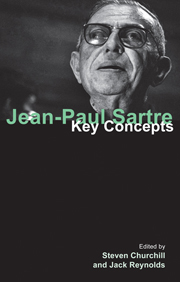Book contents
- Frontmatter
- Contents
- Contributors
- Acknowledgements
- Note on abbreviations
- 1 Introduction: Sartre vivant
- 2 Life and works
- Part I PSYCHOLOGY, PSYCHOANALYSIS AND LITERATURE
- Part II ONTOLOGY: FREEDOM, AUTHENTICITY AND SELF-CREATION
- 8 Nothingness and negation
- 9 The look
- 10 Bad faith
- 11 Authenticity
- 12 Knowledge
- 13 The fundamental project
- 14 Self-making and alienation: from bad faith to revolution
- Part III ETHICS AND POLITICS
- Bibliography
- Index
9 - The look
from Part II - ONTOLOGY: FREEDOM, AUTHENTICITY AND SELF-CREATION
- Frontmatter
- Contents
- Contributors
- Acknowledgements
- Note on abbreviations
- 1 Introduction: Sartre vivant
- 2 Life and works
- Part I PSYCHOLOGY, PSYCHOANALYSIS AND LITERATURE
- Part II ONTOLOGY: FREEDOM, AUTHENTICITY AND SELF-CREATION
- 8 Nothingness and negation
- 9 The look
- 10 Bad faith
- 11 Authenticity
- 12 Knowledge
- 13 The fundamental project
- 14 Self-making and alienation: from bad faith to revolution
- Part III ETHICS AND POLITICS
- Bibliography
- Index
Summary
Introduction
Other people have a special place in our lives. Many of our favourite activities – from sports to serious conversations – essentially involve others, and numerous things that we can do by ourselves – watch a good movie, taste wine, visit museums – are just more fun if we can share the experience with someone. At the same time, other people are also the ones from whom we try to hide if we have done something dumb, embarrassing or morally wrong. And others can bore, annoy, threaten and harm us in a multitude of different ways. As we all know too well, life with others is not always pure bliss; indeed, as a character in Sartre's play No Exit (Sartre 1945b, 1955) puts it, other people can be “hell”. An emphasis on the more negative aspects of human social life is evident in most of what Sartre writes about our relations with others in Being and Nothingness, including his famous analysis of the fundamental encounter with the other in the shape of what Sartre terms “the look”.
The present chapter offers a presentation and defence of Sartre's analysis of the look. Since Sartre develops his account against the back-drop of what he views as the shortcomings of the analyses of the social encounter offered by his phenomenological predecessors, we need to have a basic grasp of what those analyses contain.
- Type
- Chapter
- Information
- Jean-Paul SartreKey Concepts, pp. 106 - 117Publisher: Acumen PublishingPrint publication year: 2013

